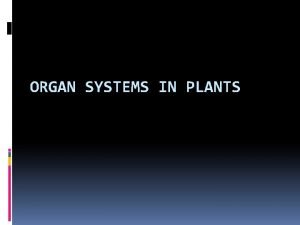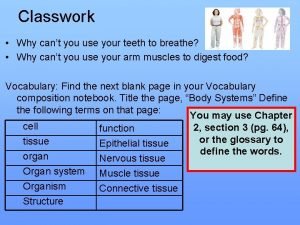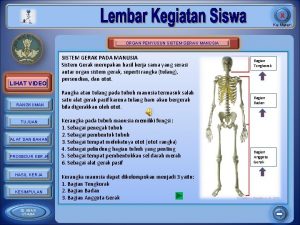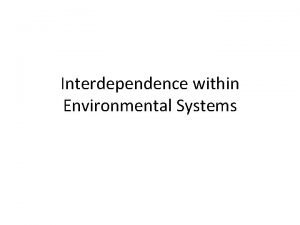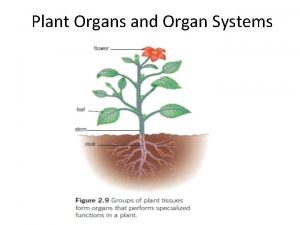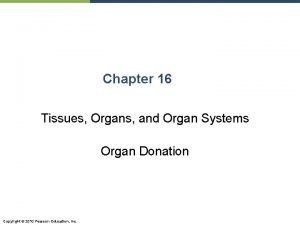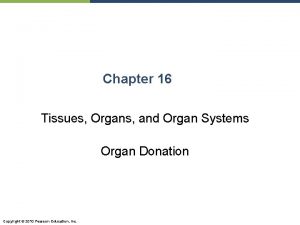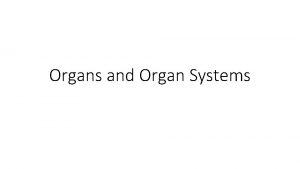Organ Systems Animals Plants and Interdependence Organs What












- Slides: 12

Organ Systems Animals, Plants and Interdependence

Organs? • What is an organ? – Organized group of tissues that performs a specific function. § Atoms § Molecules § Cells § Tissues § Organ systems § Organisms

Animal Organs • 4 types of tissues: – epithelial, connective, muscle and nervous • Example: Skin – largest organ in your body – Protects inner cells from damage, acts as defense, insulates, releases heat and excretes wastes – Epidermis is outer layer and acts as protective layer • Epithelial tissue – Dermis is connective tissue, nervous tissue and muscle tissue • Connective – blood and blood vessels, fat for insulation • Nervous – tissue to detect pain, pressure, heat and cold • Muscle - goosebumps


Plant Organs • 4 types of tissues: – epidermal, ground, vascular and meristematic • Organs in a plant are: – root, leaf, stem and flower or fruit • Example: Leaf – where photosynthesis happens – Vascular tissue – water to and within the leaf, sugar produced to the rest of the plant – Epidermal tissue – holes called stomata facilitate gases – Ground tissue – mesophyll is where photosynthesis happens


Animal Organ Systems • There are 11 main organ systems in the human body – integumentary, digestive, respiratory, circulatory and excretory • Example: Digestive Organ System – Tube within a tube in which absorption takes place • Small intestine into the bloodstream • Earthworm – food in the mouth, muscular contractions move it to the crop muscular gizzard intestines anus • Fish – teeth to grab prey stomach digestion in intestine anus • Frog – teeth and tongue to grab prey pressure of swallowing to get food into gullet esophagus stomach intestines cloaca

Animal Organ Systems • Integumentary – skin (epidermis and dermis) – accessory structures (horns, antlers, hooves, quills, claws and nails • Respiratory – Obtain oxygen and release carbon dioxide – Trachea bronchus bronchioles alveoli bloodstream • Circulatory – Arteries, arterioles, capillaries, venules, veins, heart, blood • Excretory – Kidneys, ureters, urinary bladder, urethra and skin – Filters waste products from the blood and maintains water and electrolytes

Plant Organ Systems • Root System and Shoot System – Shoot – everything above the ground – Root – everything below the ground • Example of Interdependence – Water flow • Root pressure • Capillary action • Transpiration pull

Homeostasis • Maintaining an internal steady state and organ systems work together to facilitate this • Example of interdependence: • Your circulatory system works to get blood to all parts of your body and the reason is to get oxygen to all cells and wastes away. Additionally, nutrients that have been absorbed by the digestive system are passed to the cells of your body via the circulatory system.

Interdependence of Organs • Think of how the following all interact with each other. Provide an example of an activity with an explanation. • Integumentary • Circulatory • Respiratory • Skeletal • Muscular • Nervous

Problems With Organ Systems • Circulatory System – Pulse – 60 -80 bpm – Blood pressure – 120/80 mm of Hg • Systolic and diastolic pressures • Excretory System – Urine test – Kidneys remove urea, water and other wastes from blood • White blood cells in urine indicate an infection in the excretory system • Too little urine may mean kidneys are not working effectively • Too much urine may mean pancreas is not working effectively • Prescription and illegal drugs as well as performance enhancers
 Consumer producer decomposer
Consumer producer decomposer Detritus food chain
Detritus food chain Carnivore
Carnivore Organ and organ system
Organ and organ system What is a group of organs working together
What is a group of organs working together Cell tissue organ organ system organism
Cell tissue organ organ system organism Cell to tissue to organ to organ system to organism
Cell to tissue to organ to organ system to organism Organ penyusun sistem gerak adalah …
Organ penyusun sistem gerak adalah … Organ organ pernafasan
Organ organ pernafasan Penyusun sistem saraf pusat adalah
Penyusun sistem saraf pusat adalah Category 5 interdependence within environmental systems
Category 5 interdependence within environmental systems Category 5 interdependence within environmental systems
Category 5 interdependence within environmental systems Interdependence within environmental systems
Interdependence within environmental systems




